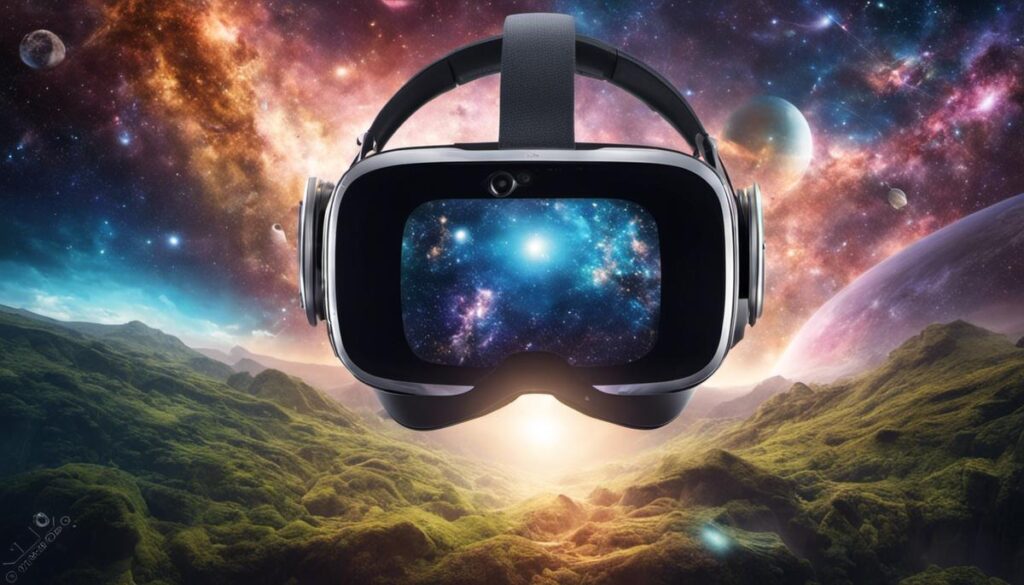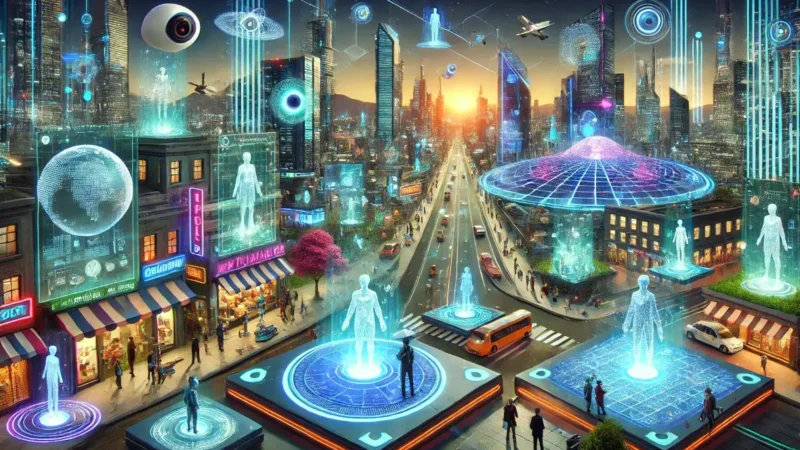Exploring the Metaverse: Future of Digital Reality

In the era of digitization, we find ourselves standing at the doorstep of the next breakthrough technology – the Metaverse. This new frontier represents an immersive digital universe where human interaction converges with augmented and virtual realities, creating a space that defies the boundaries of physical existence and transcends into the virtual world. Being more than just a concept, it’s a blend of various technological elements such as Virtual Reality (VR), Augmented Reality (AR), and 3D graphics, all combined to simulate advanced digital environments. This unification of realities offers limitless possibilities and revolutionary applications, casting a new light on areas like gaming, education, and business. This journey will provide a comprehensive understanding of the metaverse, its underlying technologies, historical evolution, applications, challenges, and what the future holds.
Understanding the Concept of Metaverse
Defining
The metaverse is a concept that encapsulates the combination of multiple elements of technology, including virtual reality (VR), augmented reality (AR), and video gaming. It represents an expansive online universe or a series of interconnected digital spaces where users can interact with a computer generated environment and other users. It includes real-time 3D virtual spaces that can host different activities for multiple users simultenously. These activities can range from work meetings, educational seminars, and social interactions, to gaming, shopping, and many more features, thereby replicating the physical world in a digital format.
Elements
Virtual Reality and Augmented Reality are fundamental components of the metaverse. VR allows users to have completely immersive experiences in a virtual world that often require VR headsets. Meanwhile, AR layers digital elements onto our view of the real world, creating a blend of physical and virtual reality, which could be accessed through devices like smartphones, tablets, and smart glasses. Video games, particularly massive multiplayer online games (MMOs), are also seen as formative factors as they often mimic complex, populated digital societies.
Characteristics
The metaverse, in its ideal form, would be persistently present; meaning it would continue to exist and evolve even when individual users are not logged in. The experiences in the metaverse would also be highly immersive, involving rich graphical visuals and spatial audio along with possible sensory feedback. Contextual AI and real-time aspects would also contribute to tailored, unique experiences for users. Another important aspect would be the interoperability: the ability to carry identities, possessions, earned attributes, and even reputational capital across various spaces of the metaverse.
Metaverse as a Digital Universe
The perspective on the metaverse as a digital universe infers a collective virtual shared space that’s created by the convergence of virtually enhanced physical reality and physically persistent virtual reality. This digital universe is expected to be populated by avatars that are 3D digital identities hence blurring the boundaries between the physical and the digital world. This will change the way we interact, socialize, work, and experience the world around us.
Potential
The metaverse carries the potential to revolutionize various sectors, including social media, retail, education, and even real estate. Owing to the immersive and interactive nature of the metaverse, consumers can test, visualize, and customize products in 3D before purchasing. It promises a new dimension of customer interaction and engagement in a virtual space. Countless other possibilities exist with the implementation of blockchain technology, such as ownership, trading, and real estate transactions in the metaverse.
Concerns and Ethical Considerations
However, it’s crucial to consider ethical implications and challenges such as data privacy, security, misinformation, and potential for monopoly or misuse. User data could be exploited for commercial gain. Environmental considerations also exist due to the high energy consumption of running powerful servers for the metaverse. Moreover, critiques point out the risk of increasing isolation and mental health issues from living extraordinarily digitally augmented or even fully virtual lives.
The concept of the metaverse is undoubtedly thrilling and futuristic, holding immense transformative power. Nevertheless, its ultimate impact on our society and individual lives is largely dependent on the ways it is developed, governed, and adopted.
Technologies Behind the Metaverse
Diving Into Virtual Reality (VR)
Virtual Reality (VR) spearheads the driving forces behind the inception and evolution of the metaverse. VR technology offers users complete immersion within a 3D, digital universe. By donning a VR headset, users can explore digital landscapes that seem to emanate the sensory experiences of real life. These virtual settings could range from imaginative fictional worlds to the most faithful recreations of actual places—making them a perfect match for the metaverse’s inception.
Capitalizing on the power of high-speed processing and advanced coding, VR systems record the user’s head and potentially body movements in real time. The gathered data then alters the user’s virtual point of view, forging a sense of movement within this virtual space. This ability to create interactive, responsive experiences is a key element in the evolution of a metaverse.
Augmented Reality (AR)
Augmented Reality (AR) is another technology crucial to the creation of the metaverse. Different from VR, AR overlays digital content onto the real world, blending physical and virtual worlds. For instance, a user could use an AR app on their smartphone to visualize furniture in their own room before they buy it, or play a game that has virtual creatures appearing in their actual location.
AR technology uses a combination of components like cameras, sensors, and screens on devices like smartphones or AR glasses. It identifies specific markers or uses location data to trigger the overlaying of digital content. AR allows for interactive experiences since the digital objects react to the user’s interactions with the real world, crucial for an immersive metaverse.
3D Graphics
3D graphics are foundational to creating the visually complex and realistic environments found in the metaverse. Through the combination of advanced graphic design technologies and computer programming, designers are capable of creating highly detailed, interactive, and aesthetically rich environments.
3D graphics work by using digital representations of 3D objects within a virtual environment. These objects are usually developed by designers or generated through software algorithms. Each object is made up of polygons; the more polygons used, the more detailed and realistic the object appears.
Lighting, shading, texturing, and rendering techniques are then applied to these objects to create an illusion of depth, shadow, and other real-world visual effects, contributing to the immersive quality of these environments.
Exploring the Role of Various Technologies in the Metaverse
The Metaverse lavishly incorporates Virtual Reality (VR), Augmented Reality (AR), and 3D visuals, all under the larger Mixed Reality (MR) umbrella. In MR, the interplay between the real and the virtual world is skillfully woven, creating never-before-seen environments where the physical and the digital can seamlessly coexist and interact in real time.
It is crucial to note that none of these technologies function in complete isolation within the Metaverse landscape. Rather, they overlap and interlink organically. For example, a metaverse-bound journey might commence with an AR experience, smoothly transition into a VR realm, and unfailingly feature high-definition 3D graphics throughout. When these technologies, together with the power of artificial intelligence, blockchain technology, and more, are collectively harnessed, it paves the way for a fully immersive, interactive, metaverse ecosystem, fostering fresh and exciting modes of digital content interaction.

Evolution of the Metaverse
Tracing the Origins and Evolution
Diving into its conceptual roots, the Metaverse sprung to life in the realm of science fiction, marking its debut in Neal Stephenson’s 1992 novel, “Snow Crash.” In this whirlwind fictitious universe, Stephenson envisioned the Metaverse as a digital mirroring of reality—a place where individuals, represented via avatars, could engage in interactions, be they with each other or with the digital environment itself. This rudimentary idea of the Metaverse, as an interactive, communal virtual space, continues to inspire, gradually shaping our contemporary and ever-evolving perception of what the Metaverse could truly be.
Key Moments in the Evolution
The evolution of the metaverse has been marked by key moments, most of which revolve around technological advancements. The late 90s and early 2000s saw the proliferation of massively multiplayer online role-playing games (MMORPGs), in which large numbers of players could simultaneously interact in a virtual world. “Second Life,” launched in 2003, was an ambitious metaverse-like platform where users could socialize, participate in activities, create and trade virtual property, providing an experience more aligned with Stephenson’s vision of a metaverse.
In the 2010s, the concept of the metaverse took a huge leap forward with the advent of Virtual Reality (VR) technology. The development of this technology enabled the introduction of new layers of immersion, interaction, and experience into the envisioned metaverse, with platforms like “Minecraft” and “Fortnite” creating game-world ecosystems supporting user-created content, in-game economies, and social experiences that moved beyond gaming.
The Metaverse’s Current Form and Future
Currently, the metaverse is characterized by various interconnected virtual reality spaces enabling users, through the use of avatars, to interact with digitized versions of others in real-time while also interacting with the digital environment.
The multimedia conglomerate Facebook’s decision to rebrand itself as Meta in 2021, as part of its broader strategy to create an immersive digital metaverse, is another recent development that underlines the significance of the metaverse in current technology trends.
As technologies like Virtual and Augmented Reality, AI, and blockchain continue to evolve, the form and operational dynamics of the metaverse are also expected to be shaped accordingly, providing even more immersive, interactive, and complex digital spaces.
Emerging Impact
The development of the metaverse is anticipated to be a gamechanger. This new concept, currently under extensive development by leading tech companies and emerging startups, is predicted to change not only our social interactions but also the way we work, educate ourselves, and engage with virtual content. This envisaged multidimensional metaverse promises to profoundly influence the future of digital interaction.

Photo by mirzaie on Unsplash
Potential Applications of the Metaverse
Gaming’s Role
The gaming sector has a significant role in realizing the metaverse concept. Here, players can lose themselves in an expansive digital universe where they can play various games, connect with other users, and even shape the virtual realm itself. Games such as Fortnite, Minecraft, and Roblox are pioneers in integrating elements of the metaverse. Further indications of a burgeoning metaverse come from Epic Games, Fortnite’s creator, who are starting to stage live concerts and other non-game-centric events within their gaming platform.
Metaverse for Social Interaction
Beyond gaming, the metaverse holds incredible potential as a new realm of social interaction. In a meta, users might maintain digital identities, or avatars, and interact with others’ avatars in a digital space. They could attend virtual concerts, hang out in digital parks, or explore fully interactive 3D worlds. Facebook has signaled its intent to build this type of metaverse, rebranding itself as Meta.
Metaverse in Education
Consider a virtual classroom where students from around the world can interact as if in the same physical room. A teacher might take students on a virtual field trip to Ancient Greece or inside the human body. The incorporation of the metaverse into education has the potential to enhance learning experiences, engagement, and global collaboration. Companies like Engage and Lifeliqe are already exploring virtual and augmented reality learning solutions, signaling possible future meta applications in education.
Metaverse and Business
Lastly, the business sector can hugely benefit from a metaverse. Businesses can create digital storefronts or showrooms, with customers visiting and interacting with products in a 3D space. Ecommerce would evolve from two-dimensional product images to 3D product interactions. Remote work, too, could be revolutionized, with meetings happening in virtual conference rooms. Microsoft’s Mesh platform, for instance, offers shared virtual experiences for collaborative work.
Real-World Metaverse Applications
Real-world examples of metaverse applications are beginning to emerge. The online game Second Life, for instance, offers a digital world where users create avatars, build homes, and interact with each other. Decentraland is another example, a decentralized digital world where users own and control the land. Users can create, explore, and trade in Decentraland, demonstrating monetary possibilities within the metaverse.
The possibilities hinted at by the metaverse are only scratching the tip of the iceberg. As technological progress continues to evolve and the concept matures, new and unanticipated benefits will surely materialize.

Challenges and Future of Metaverse
Understanding the Metaverse’s Obstacles
The journey towards the implementation of the Metaverse is not without its drawbacks, privacy being a prominent one. These virtual environments are treasure troves of personal data, containing both user-provided data and behavioural patterns tracked within these digital realms. Safeguarding this sheer volume of data against breaches and potential misuse is a serious matter, given the longstanding struggles of digital platforms with privacy violations.
Additionally, the metaverse’s march forward is hindered by hardware constraints. The main medium of interfacing with the Metaverse, VR headsets, poses a challenge with their high expenses and inconsistent quality. On top of this, the need for high bandwidth and processing power to render high-resolution, lifelike, and total immersive environments may restrict access for some. Many users globally, especially in developing nations, lack the high-speed, reliable internet connection that would bring these experiences to life.
Future Prospects
Despite these challenges, the Metaverse offers a wealth of opportunities across various sectors. Entertainment, gaming, and social networking are the obvious arenas for the Metaverse. However, its potential goes far beyond these fields.
In education, for example, the Metaverse could revolutionize remote learning by providing immersive and interactive environments that simulate traditional classroom settings or even create learning experiences impossible in the physical world. The Metaverse also has potential applications in healthcare, where virtual reality is already being used for patient treatment and medical training. Through the Metaverse, this could be extended to include virtual hospitals or rehabilitation spaces that patients can access from home.
In business, the Metaverse could enable new forms of remote work, offer immersive shopping experiences that blend online and in-store shopping, and provide virtual spaces for customer engagement and product demonstrations. The Metaverse might also pave the way for new types of virtual economies, with digital goods and services traded within and across communities.
Finally, while the Metaverse might seem like a realm far removed from our physical world, it could have profound implications for the environment by reducing the need for physical goods and transportation. This implies that the full realization of the Metaverse could contribute to sustainability and climate change mitigation efforts. However, this depends on the energy efficiency of the hardware and data centers powering the Metaverse.
In summary, the challenges and potential of the Metaverse represent a fascinating intersection of technology, privacy, user experience, and emerging digital economies. The implementation journey is intricately complex but has the potential to take humanity to new heights in virtually every field.
As we turn our gaze towards the horizon, it’s evident that metaverse holds substantial promise to revolutionize how we perceive and interact within virtual spaces. However, its success hinges not only on technological advancement but also on overcoming significant challenges like privacy concerns. Given its potential, the metaverse could rewrite social, educational, and economic rules as we know them. Despite hardware limitations and security issues, optimism runs high in the tech community for this compelling reality where the physical and the digital realms merge seamlessly. The metaverse is still in its nascent stage, a creation in progress, but if realized, it holds the power to not only change the landscape of the digital age, but of human existence itself.




